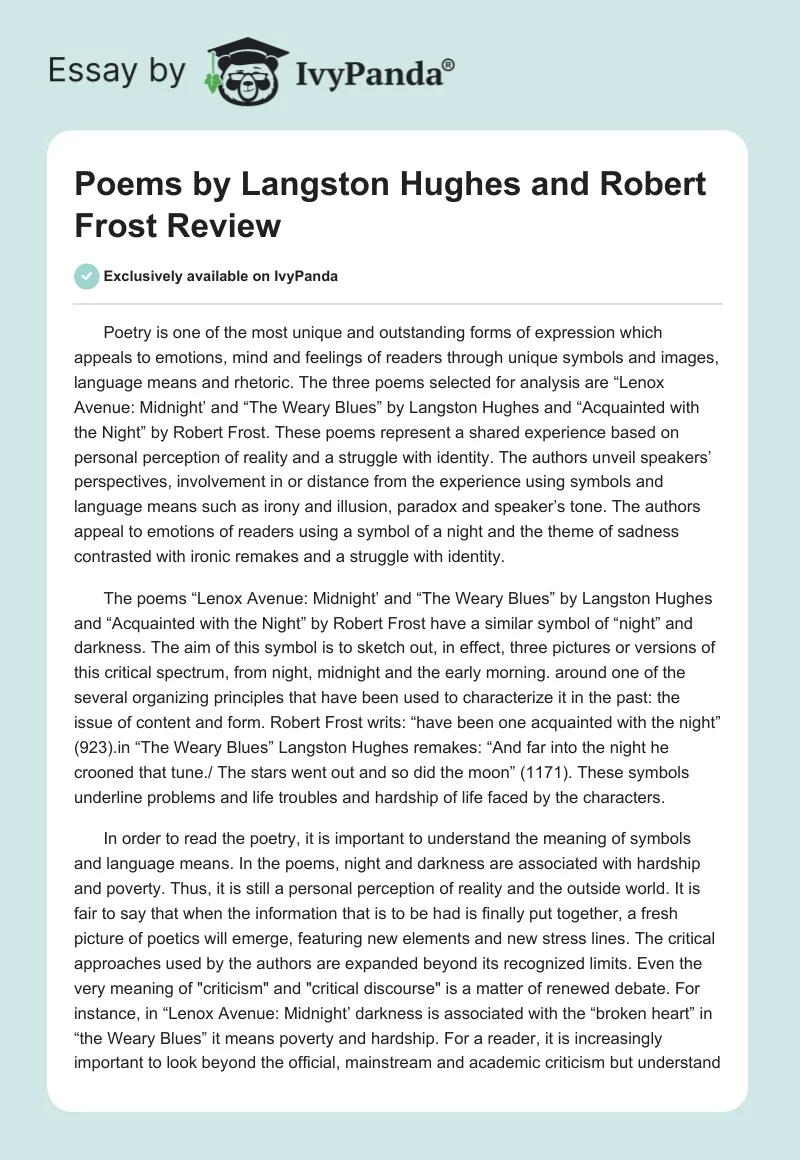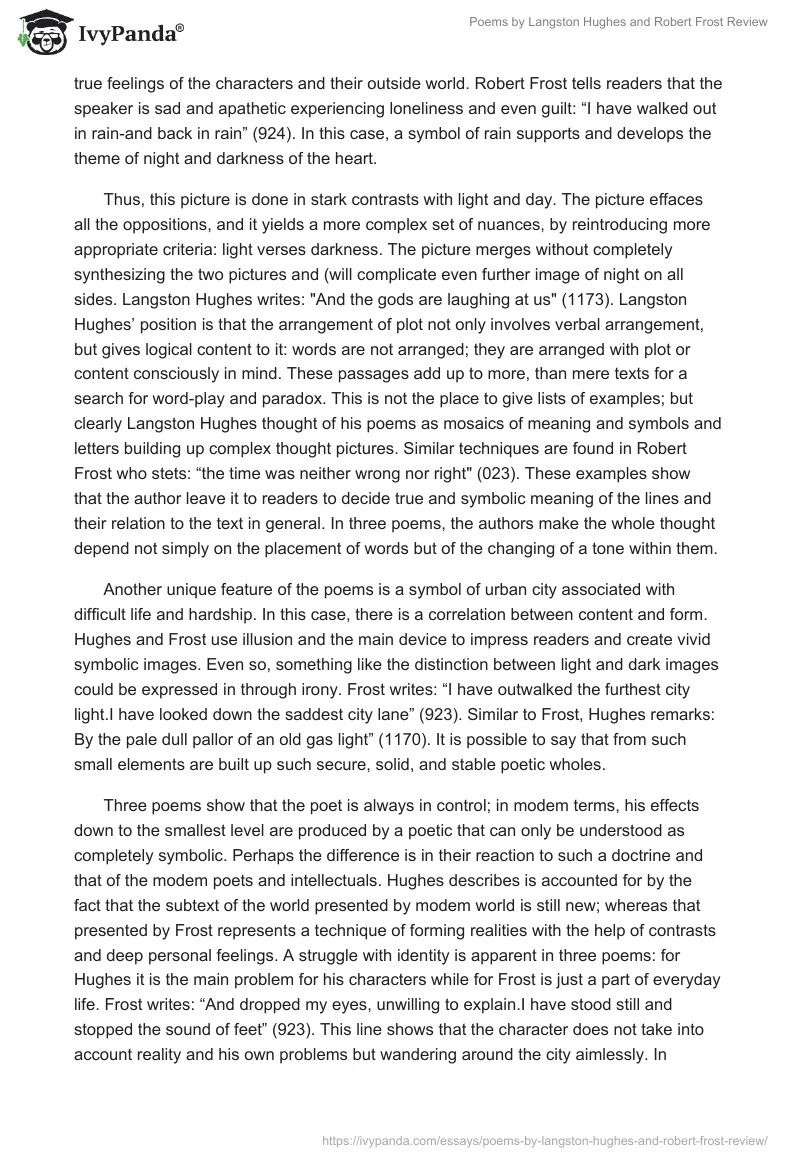Poetry is one of the most unique and outstanding forms of expression which appeals to emotions, mind and feelings of readers through unique symbols and images, language means and rhetoric. The three poems selected for analysis are “Lenox Avenue: Midnight’ and “The Weary Blues” by Langston Hughes and “Acquainted with the Night” by Robert Frost. These poems represent a shared experience based on personal perception of reality and a struggle with identity. The authors unveil speakers’ perspectives, involvement in or distance from the experience using symbols and language means such as irony and illusion, paradox and speaker’s tone. The authors appeal to emotions of readers using a symbol of a night and the theme of sadness contrasted with ironic remakes and a struggle with identity.
The poems “Lenox Avenue: Midnight’ and “The Weary Blues” by Langston Hughes and “Acquainted with the Night” by Robert Frost have a similar symbol of “night” and darkness. The aim of this symbol is to sketch out, in effect, three pictures or versions of this critical spectrum, from night, midnight and the early morning. around one of the several organizing principles that have been used to characterize it in the past: the issue of content and form. Robert Frost writs: “have been one acquainted with the night” (923).in “The Weary Blues” Langston Hughes remakes: “And far into the night he crooned that tune./ The stars went out and so did the moon” (1171). These symbols underline problems and life troubles and hardship of life faced by the characters.
In order to read the poetry, it is important to understand the meaning of symbols and language means. In the poems, night and darkness are associated with hardship and poverty. Thus, it is still a personal perception of reality and the outside world. It is fair to say that when the information that is to be had is finally put together, a fresh picture of poetics will emerge, featuring new elements and new stress lines. The critical approaches used by the authors are expanded beyond its recognized limits. Even the very meaning of “criticism” and “critical discourse” is a matter of renewed debate. For instance, in “Lenox Avenue: Midnight’ darkness is associated with the “broken heart” in “the Weary Blues” it means poverty and hardship. For a reader, it is increasingly important to look beyond the official, mainstream and academic criticism but understand true feelings of the characters and their outside world. Robert Frost tells readers that the speaker is sad and apathetic experiencing loneliness and even guilt: “I have walked out in rain-and back in rain” (924). In this case, a symbol of rain supports and develops the theme of night and darkness of the heart.
Thus, this picture is done in stark contrasts with light and day. The picture effaces all the oppositions, and it yields a more complex set of nuances, by reintroducing more appropriate criteria: light verses darkness. The picture merges without completely synthesizing the two pictures and (will complicate even further image of night on all sides. Langston Hughes writes: “And the gods are laughing at us” (1173). Langston Hughes’ position is that the arrangement of plot not only involves verbal arrangement, but gives logical content to it: words are not arranged; they are arranged with plot or content consciously in mind. These passages add up to more, than mere texts for a search for word-play and paradox. This is not the place to give lists of examples; but clearly Langston Hughes thought of his poems as mosaics of meaning and symbols and letters building up complex thought pictures. Similar techniques are found in Robert Frost who stets: “the time was neither wrong nor right” (023). These examples show that the author leave it to readers to decide true and symbolic meaning of the lines and their relation to the text in general. In three poems, the authors make the whole thought depend not simply on the placement of words but of the changing of a tone within them.
Another unique feature of the poems is a symbol of urban city associated with difficult life and hardship. In this case, there is a correlation between content and form. Hughes and Frost use illusion and the main device to impress readers and create vivid symbolic images. Even so, something like the distinction between light and dark images could be expressed in through irony. Frost writes: “I have outwalked the furthest city light.I have looked down the saddest city lane” (923). Similar to Frost, Hughes remarks: By the pale dull pallor of an old gas light” (1170). It is possible to say that from such small elements are built up such secure, solid, and stable poetic wholes.
Three poems show that the poet is always in control; in modem terms, his effects down to the smallest level are produced by a poetic that can only be understood as completely symbolic. Perhaps the difference is in their reaction to such a doctrine and that of the modem poets and intellectuals. Hughes describes is accounted for by the fact that the subtext of the world presented by modem world is still new; whereas that presented by Frost represents a technique of forming realities with the help of contrasts and deep personal feelings. A struggle with identity is apparent in three poems: for Hughes it is the main problem for his characters while for Frost is just a part of everyday life. Frost writes: “And dropped my eyes, unwilling to explain.I have stood still and stopped the sound of feet” (923). This line shows that the character does not take into account reality and his own problems but wandering around the city aimlessly. In contrast, Hughes’ characters suffer from low class location and poverty “ He played that sad raggy tune like a musical fool/ Coming from a black man’s soul” (1170). Their subject might have instructive and moral implications. Although Hughes deals only with symbol of poverty: it weakens the force of the thought by pleasure, distraction, unnatural diction, and so on.
In sum, the examples of three poems show that in order to read and understand poetry, it is important to interpreter unique symbols and images used by the poets. The authors use a symbol of a night and the theme of sadness to create unique feelings and emotions. These poems show that poets create an utterly different meaning of words on an utterly different subject every time they write about what to a glance are human sufferings. To impress readers, the authors use paradox and irony as contrasting elements and symbols. The authors pay attention to the smallest detail and the coherence of every detail with larger effects of symbols and images.
Works Cited
Meyer, M. The Bedford Introduction to Literature. 8th Edition.


